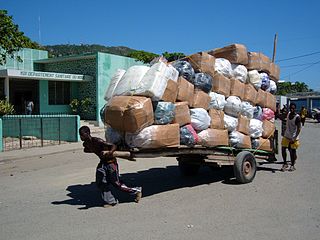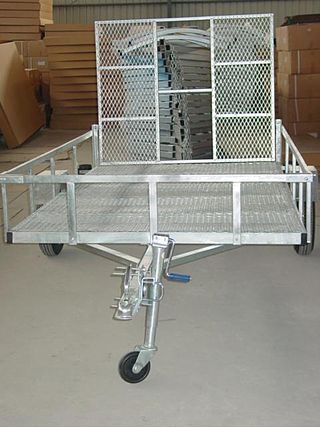
A tricycle, sometimes abbreviated to trike, is a human-powered three-wheeled vehicle.

A cart or dray is a vehicle designed for transport, using two wheels and normally pulled by one or a pair of draught animals. A handcart is pulled or pushed by one or more people.

A wheelbarrow is a small hand-propelled vehicle, usually with just one wheel, designed to be pushed and guided by a single person using two handles at the rear, or by a sail to push the ancient wheelbarrow by wind. The term "wheelbarrow" is made of two words: "wheel" and "barrow." "Barrow" is a derivation of the Old English "barew" which was a device used for carrying loads.

A stretcher, gurney, litter, or pram is an apparatus used for moving patients who require medical care. A basic type must be carried by two or more people. A wheeled stretcher is often equipped with variable height frames, wheels, tracks, or skids. Stretchers are primarily used in acute out-of-hospital care situations by emergency medical services (EMS), military, and search and rescue personnel. In medical forensics the right arm of a corpse is left hanging off the stretcher to let paramedics know it is not a wounded patient. They are also used to hold prisoners during lethal injections in the United States.

A caster is an undriven wheel that is designed to be attached to the bottom of a larger object to enable that object to be moved.

A trailer is an unpowered vehicle towed by a powered vehicle. It is commonly used for the transport of goods and materials.

A toy wagon has the same structure as the traditional, larger wagon, but is much smaller and has an open top. An average wagon is able to seat one child, and is generally propelled by human power through a handle at the front. Some famous brands are Radio Flyer, Little Tikes, Red Rider, Northern Tool and Equipment, Lowe's, Cardinal, and Speedway Express.
This article contains a list of cinematic techniques that are divided into categories and briefly described.

A bicycle trailer is a motorless wheeled frame with a hitch system for transporting cargo by bicycle. It can greatly increase a bike's cargo capacity, allowing point-to-point haulage of objects up to 3 cubic metres in volume that weigh as much as 500 kg. However, very heavily loaded trailers may pose a danger to the cyclist and others, and the voluntary European standard EN 15918 therefore suggests a maximum load of 60 kg on trailers without brakes.

A horse-drawn vehicle is a piece of equipment pulled by one or more horses. These vehicles typically have two or four wheels and were used to carry passengers or a load. They were once common worldwide, but they have mostly been replaced by automobiles and other forms of self-propelled transport but are still in use today.

Ground support equipment (GSE) is the support equipment found at an airport, usually on the apron, the servicing area by the terminal. This equipment is used to service the aircraft between flights. As the name suggests, ground support equipment is there to support the operations of aircraft whilst on the ground. The role of this equipment generally involves ground power operations, aircraft mobility, and cargo/passenger loading operations.

A stairclimber is a type of trolley fitted with rotating wheels or tracks so that it can be pushed or pulled up or down steps or a stairway. Stairclimbers can be manual or battery-powered, and are commonly found in wheel, track, push arm or walker variants.

Pallet rack is a material handling storage aid system designed to store materials on pallets. Although there are many varieties of pallet racking, all types allow for the storage of palletized materials in horizontal rows with multiple levels. Forklift trucks are usually required to place the loaded pallets onto the racks for storage. Since the Second World War, pallet racks have become a ubiquitous element of most modern warehouses, manufacturing facilities, retail centers, and other storage and distribution facilities. All types of pallet racking increase storage density of the stored goods. Costs associated with the racking increases with increasing storage density.

Material handling equipment (MHE) is mechanical equipment used for the movement, storage, control, and protection of materials, goods and products throughout the process of manufacturing, distribution, consumption, and disposal. The different types of equipment can be classified into four major categories: transport equipment, positioning equipment, unit load formation equipment, and storage equipment.

A motorized wheelchair, powerchair, electric wheelchair or electric-powered wheelchair (EPW) is a wheelchair that is propelled by means of an electric motor rather than manual power. Motorized wheelchairs are useful for those unable to propel a manual wheelchair or who may need to use a wheelchair for distances or over terrain which would be fatiguing in a manual wheelchair. They may also be used not just by people with 'traditional' mobility impairments, but also by people with cardiovascular and fatigue-based conditions.
A flatbed trolley a common form of freight transport in distribution environments, for moving bulk loads. Trolleys can aid in reducing effort required to move a load by allowing the user to pull or push instead of lift and carry. A very simple design offers a basic flat platform with four casters and a fixed handle which is used to either push or pull the platform with the load on the platform. Without a flat surface it becomes an open frame trolley and without a handle it is a bogie or dolly.
Manual material handling (MMH) work contributes to a large percentage of the over half a million cases of musculoskeletal disorders reported annually in the United States. Musculoskeletal disorders often involve strains and sprains to the lower back, shoulders, and upper limbs. They can result in protracted pain, disability, medical treatment, and financial stress for those afflicted with them, and employers often fi nd themselves paying the bill, either directly or through workers’ compensation insurance, at the same time they must cope with the loss of the full capacity of their workers.

A shopping caddy or shopping trolley is a large bag on wheels, used for carrying a large amount of shopping home on foot. The bag is typically made from a waterproof fabric, and wicker basket designs are also sold. The trolleys commonly have two parallel wheels on a hand truck style frame, but some designs have four or six wheels. Designs have recently been sold by fashion retailers Zara and Chanel.

A shoulder dolly, also known as moving straps, lifting straps, furniture moving straps, and similar names, is a lifting strap and harness used in transport and logistics which allows moving personnel to distribute the load more evenly on the shoulders and hips so that heavy lifts can be performed with less risk of back injury. They are often used in pairs by two people carrying an object between them, and are sometimes used by moving companies. In 2019, a shoulder dolly made by a British manufacturer was named a finalist in Tomorrow’s Health & Safety Awards 2019, which is part of a digital magazine for the British health and safety industry.




















